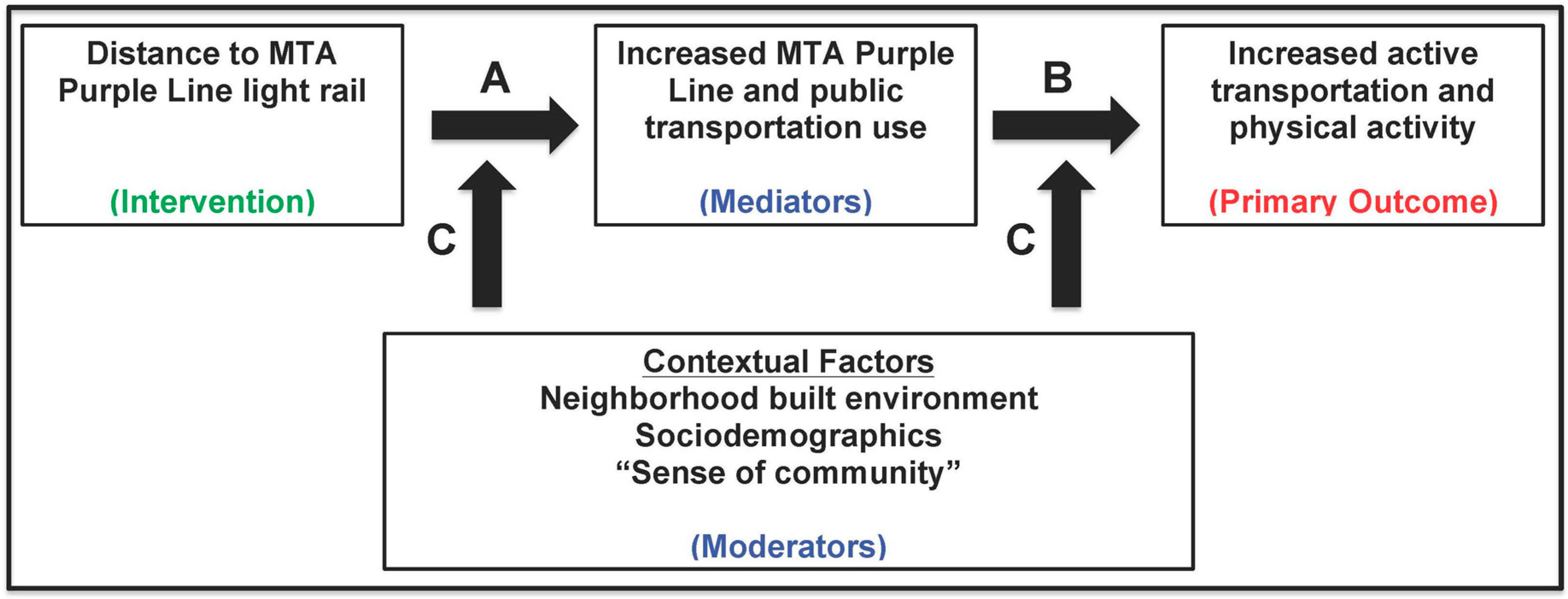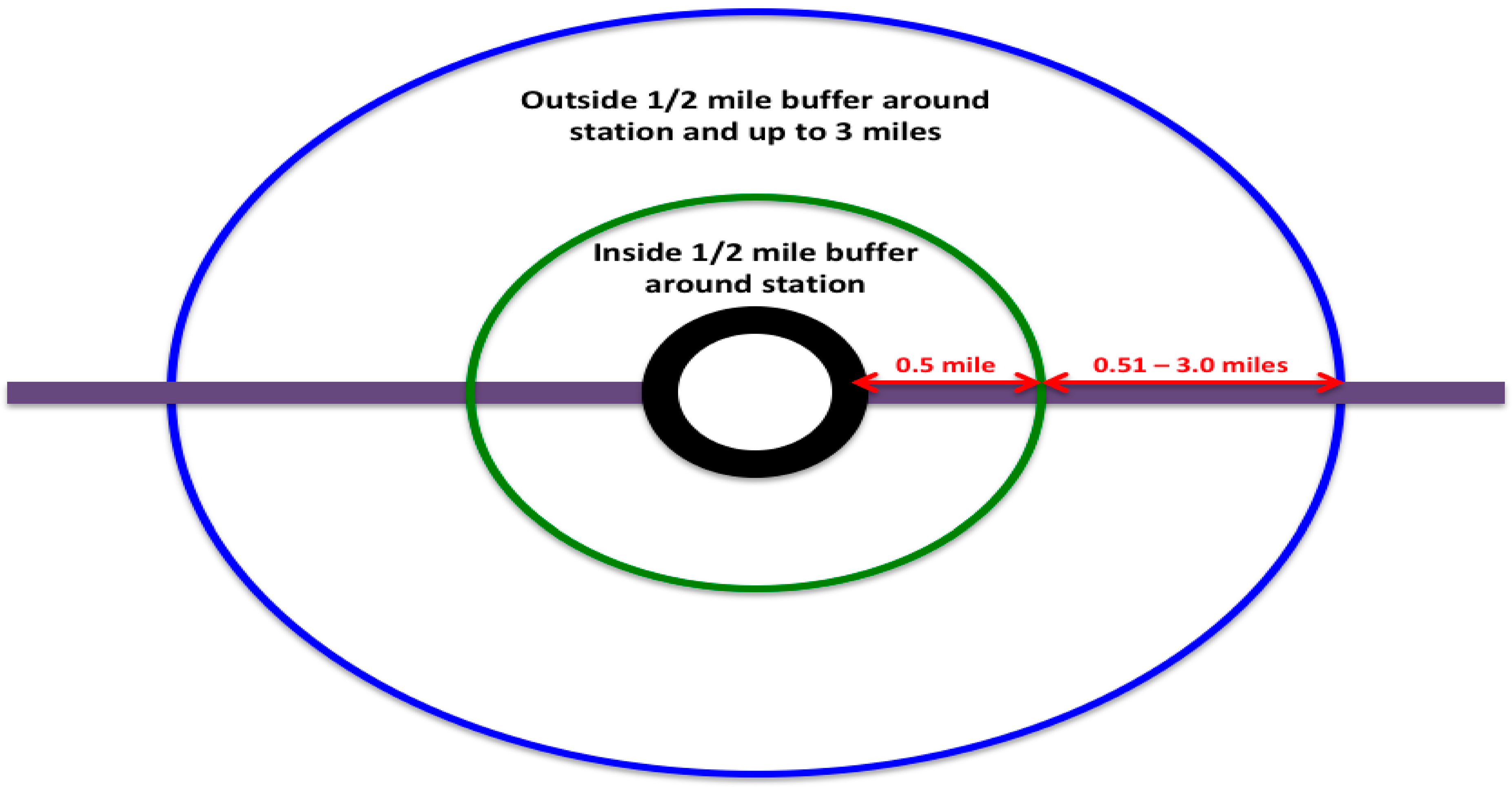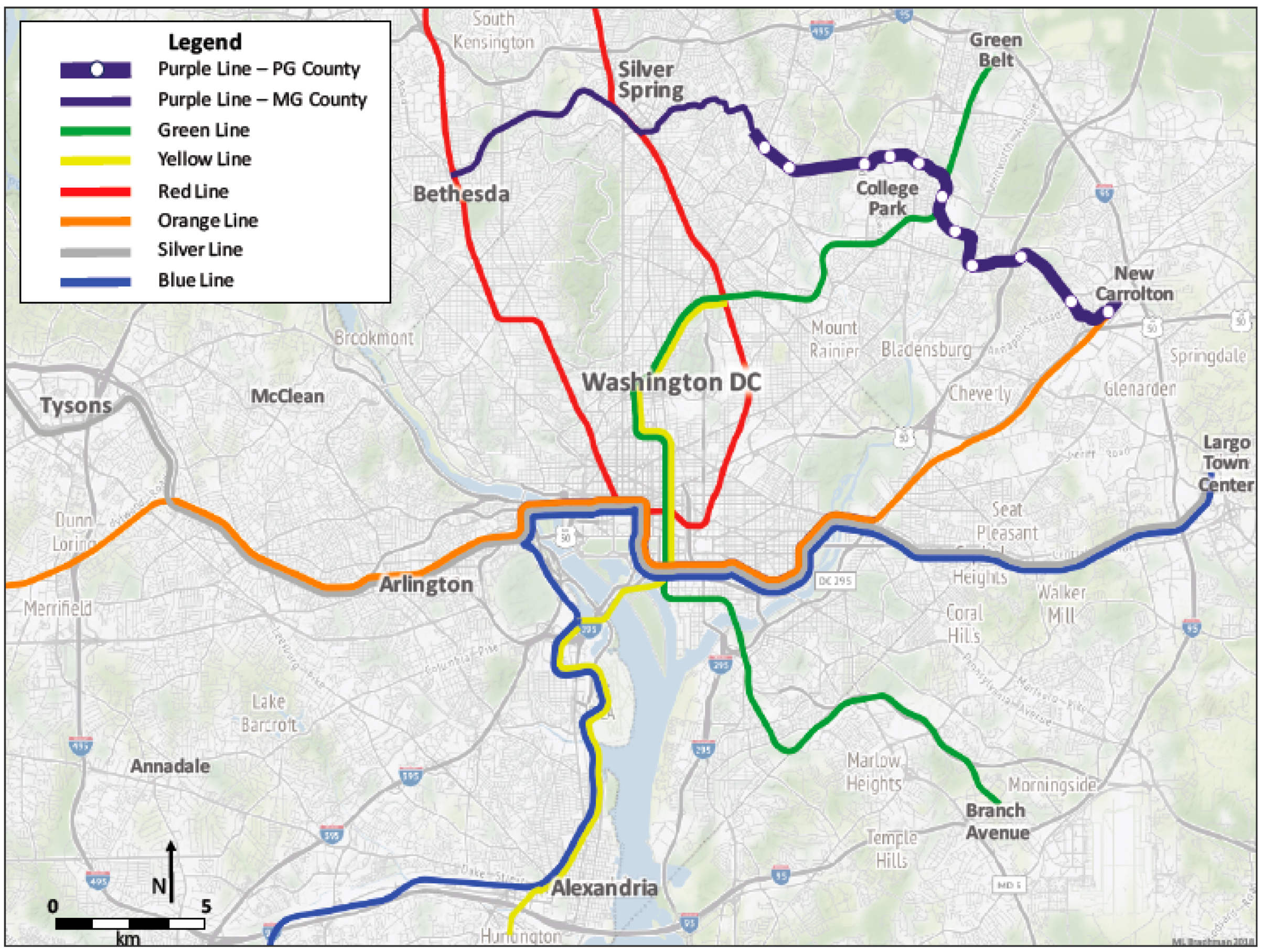Examining the Influence of a New Light Rail Line on the Health of a Demographically Diverse and Understudied Population within the Washington, D.C. Metropolitan Area: A Protocol for a Natural Experiment Study
Abstract
1. Introduction
1.1. Obesity and Physical Activity
1.2. Active Transportation
1.3. Sense of Community
1.4. Natural Experiment
1.5. Conceptual Model
2. Materials and Methods
2.1. Pre-Purple Line Period
2.1.1. Design and Sample
2.1.2. Focus Groups (Phase I)—Adults
2.1.3. Questionnaire (Phase II)—Adults and Youth
2.1.4. Accelerometry and Travel Diaries (Phase II)—Adults
2.1.5. Field-Based Audits (Phase II)—Purple Line Neighborhoods
2.2. Post-Purple Line Period
2.3. Analytic Plan
2.4. Ethics
3. Discussion
4. Conclusions
Acknowledgments
Author Contributions
Conflicts of Interest
References
- Prince George’s County Health Department. Health Report 2015. Available online: http://www.princegeorgescountymd.gov/ArchiveCenter/ViewFile/Item/1557 (accessed on 28 March 2017).
- Prince George’s County Planning Board. A Discussion of Community Health and Food Access in Prince George’s County: Prince George's County General Plan Update. Available online: http://planpgc2035.com/sites/default/files/documents/Community Health and Food Access Policy Paper.pdf (accessed on 28 March 2017).
- Centers for Disease Control and Prevention. Youth Risk Behavior Survey Results—Maryland Middle School—Prince George's County: Physical Activity Summary Tables. Available online: http://phpa.dhmh.maryland.gov/ccdpc/Reports/Documents/2014 YRBS Reports/2014PrinceGeorgeMS Summary Tables.pdf (accessed on 28 March 2017).
- Centers for Disease Control and Prevention. Youth Risk Behavior Survey Results—Maryland High School—Prince George's County: Physical Activity Summary Tables. Available online: http://phpa.dhmh.maryland.gov/ccdpc/Reports/Documents/2014 YRBS Reports/2014PrinceGeorgeHS Summary Tables.pdf (accessed on 28 March 2017).
- U.S. Department of Health and Human Service; Centers for Disease Control and Prevention. Behavioral Risk Factor Surveillance System Survey—Prevalence & Trends Data. Maryland Overweight/Obesity. Available online: https://www.cdc.gov/brfss/brfssprevalence/index.html (accessed on 1 April 2017).
- State of Obesity. Special Report: Better Policies for a Healthier America. Racial and Ethnic Disparities in Obesity—An In-Depth Look at the Inequities that Contribute to Higher Obesity Rates in Black and Latino Communities. Available online: http://stateofobesity.org/files/stateofobesity2015.pdf (accessed on 14 October 2016).
- U.S. Department of Health and Human Service; Centers for Disease Control and Prevention. Behavioral Risk Factor Surveillance System Survey—Prevalence & Trends Data. Maryland Physical Activity. Available online: https://www.cdc.gov/brfss/brfssprevalence/index.html (accessed on 1 April 2017).
- Pratt, M.; Macera, C.A.; Sallis, J.F.; O’Donnell, M.; Frank, L.D. Economic interventions to promote physical activity: Application of the SLOTH model. Am. J. Prev. Med. 2004, 27, 136–145. [Google Scholar] [CrossRef] [PubMed]
- Besser, L.M.; Dannenberg, A.L. Walking to public transit: Steps to help meet physical activity recommendations. Am. J. Prev. Med. 2005, 29, 273–280. [Google Scholar] [CrossRef] [PubMed]
- Lachapelle, U. Walk, Bicycle, and Transit Trips of Transit-Dependent and Choice Riders in the 2009 United States National Household Travel Survey. J. Phys. Act. Health 2015, 12, 1139–1147. [Google Scholar] [CrossRef] [PubMed]
- Lachapelle, U.; Frank, L.D. Transit and health: Mode of transport, employer-sponsored public transit pass programs, and physical activity. J. Public Health Policy 2009, 30, S73–S94. [Google Scholar] [CrossRef] [PubMed]
- Chaix, B.; Kestens, Y.; Duncan, S.; Merrien, C.; Thierry, B.; Pannier, B.; Brondeel, R.; Lewin, A.; Karusisi, N.; Perchoux, C.; et al. Active transportation and public transportation use to achieve physical activity recommendations? A combined GPS, accelerometer, and mobility survey study. Int. J. Behav. Nutr. Phys. Act. 2014, 11, 124. [Google Scholar] [CrossRef] [PubMed]
- Rissel, C.; Curac, N.; Greenaway, M.; Bauman, A. Physical activity associated with public transport use—A review and modelling of potential benefits. Int. J. Environ. Res. Public Health 2012, 9, 2454–2478. [Google Scholar] [CrossRef] [PubMed]
- Bopp, M.; Gayah, V.V.; Campbell, M.E. Examining the link between public transit use and active commuting. Int. J. Environ. Res. Public Health 2015, 12, 4256–4274. [Google Scholar] [CrossRef] [PubMed]
- Edwards, R.D. Public transit, obesity, and medical costs: Assessing the magnitudes. Prev. Med. 2008, 46, 14–21. [Google Scholar] [CrossRef] [PubMed]
- MacDonald, J.M.; Stokes, R.J.; Cohen, D.A.; Kofner, A.; Ridgeway, G.K. The effect of light rail transit on body mass index and physical activity. Am. J. Prev. Med. 2010, 39, 105–112. [Google Scholar] [CrossRef] [PubMed]
- Villanueva, K.; Giles-Corti, B.; McCormack, G. Achieving 10,000 steps: A comparison of public transport users and drivers in a university setting. Prev. Med. 2008, 47, 338–341. [Google Scholar] [CrossRef] [PubMed]
- Lachapelle, U.; Frank, L.; Saelens, B.E.; Sallis, J.F.; Conway, T.L. Commuting by public transit and physical activity: Where you live, where you work, and how you get there. J. Phys. Act. Health 2011, 8, S72–S82. [Google Scholar] [CrossRef] [PubMed]
- Stokes, R.J.; MacDonald, J.; Ridgeway, G. Estimating the effects of light rail transit on health care costs. Health Place 2008, 14, 45–58. [Google Scholar] [CrossRef] [PubMed]
- Wasfi, R.A.; Ross, N.A.; El-Geneidy, A.M. Achieving recommended daily physical activity levels through commuting by public transportation: Unpacking individual and contextual influences. Health Place 2013, 23, 18–25. [Google Scholar] [CrossRef] [PubMed]
- Manaugh, K.; El-Geneidy, A.M. Does distance matter? Exploring the links among values, motivations, home location, and satisfaction in walking trips. Transp. Res. Part A 2013, 50, 198–208. [Google Scholar] [CrossRef]
- Ostergaard, L.; Kolle, E.; Steene-Johannessen, J.; Anderssen, S.A.; Andersen, L.B. Cross sectional analysis of the association between mode of school transportation and physical fitness in children and adolescents. Int. J. Behav. Nutr. Phys. Act. 2013, 10, 91. [Google Scholar] [CrossRef] [PubMed]
- Drenowatz, C.; Kobel, S.; Kettner, S.; Kesztyus, D.; Wirt, T.; Dreyhaupt, J.; Steinacker, J.M. Correlates of weight gain in German children attending elementary school. Prev. Med. 2013, 57, 310–314. [Google Scholar] [CrossRef] [PubMed]
- Andersen, L.B.; Lawlor, D.A.; Cooper, A.R.; Froberg, K.; Anderssen, S.A. Physical fitness in relation to transport to school in adolescents: The Danish youth and sports study. Scand. J. Med. Sci. Sports 2009, 19, 406–411. [Google Scholar] [CrossRef] [PubMed]
- Booth, M.L.; Okely, A.D.; Denney-Wilson, E.; Hardy, L.L.; Dobbins, T.; Wen, L.M.; Rissel, C. Characteristics of travel to and from school among adolescents in NSW, Australia. J. Paediatr. Child Health 2007, 43, 755–761. [Google Scholar] [CrossRef] [PubMed]
- Saelens, B.E.; Moudon, A.V.; Kang, B.; Hurvitz, P.M.; Zhou, C. Relation between higher physical activity and public transit use. Am. J. Public Health 2014, 104, 854–859. [Google Scholar] [CrossRef] [PubMed]
- Saelens, B.E.; Sallis, J.F.; Frank, L.D. Environmental correlates of walking and cycling: Findings from the transportation, urban design, and planning literatures. Ann. Behav. Med. 2003, 25, 80–91. [Google Scholar] [CrossRef] [PubMed]
- Johansson, K.; Hasselberg, M.; Laflamme, L. Young adolescents’ independent mobility, related factors and association with transport to school. A cross-sectional study. BMC Public Health 2010, 10, 635. [Google Scholar] [CrossRef] [PubMed]
- Trapp, G.S.; Giles-Corti, B.; Christian, H.E.; Bulsara, M.; Timperio, A.F.; McCormack, G.R.; Villaneuva, K.P. Increasing children’s physical activity: Individual, social, and environmental factors associated with walking to and from school. Health Educ. Behav. 2012, 39, 172–182. [Google Scholar] [CrossRef] [PubMed]
- Cloutier, M.S.; Bergeron, J.; Apparicio, P. Predictors of parental risk perceptions: The case of child pedestrian injuries in school context. Risk Anal. 2011, 31, 312–323. [Google Scholar] [CrossRef] [PubMed]
- Miller, W.C.; Redmond, J.G.; Vaux-Bjerke, A.T. Activity patterns and perceptions about active transport to school. Am. J. Health Behav. 2013, 37, 190–198. [Google Scholar] [CrossRef] [PubMed]
- Owen, C.G.; Nightingale, C.M.; Rudnicka, A.R.; Sluijs, E.M.; Ekelund, U.; Cook, D.G.; Whincup, P.H. Travel to school and physical activity levels in 9–10 year-old UK children of different ethnic origin; Child Heart and Health Study in England (CHASE). PLoS ONE 2012, 7, e30932. [Google Scholar] [CrossRef] [PubMed]
- Timperio, A.; Crawford, D.; Telford, A.; Salmon, J. Perceptions about the local neighborhood and walking and cycling among children. Prev. Med. 2004, 38, 39–47. [Google Scholar] [CrossRef] [PubMed]
- Johansson, K.; Laflamme, L.; Hasselberg, M. Active commuting to and from school among Swedish children—A national and regional study. Eur. J. Public Health 2012, 22, 209–214. [Google Scholar] [CrossRef] [PubMed]
- Brown, B.B.; Werner, C.M.; Tribby, C.P.; Miller, H.J.; Smith, K.R. Transit use, physical activity, and body mass index changes: Objective measures associated with complete street light-rail construction. Am. J. Public Health 2015, 105, 1468–1474. [Google Scholar] [CrossRef] [PubMed]
- Puddifoot, J.E. Dimensions of community identity. J. Community Appl. Soc. Psychol. 1995, 5, 357–370. [Google Scholar] [CrossRef]
- McMillan, D.W.; Chavis, D.M. Sense of community: A definition and theory. J. Community Psychol. 1986, 14, 6–23. [Google Scholar] [CrossRef]
- Sallis, J.F.; Floyd, M.F.; Rodriguez, D.A.; Saelens, B.E. Role of built environments in physical activity, obesity, and cardiovascular disease. Circulation 2012, 125, 729–737. [Google Scholar] [CrossRef] [PubMed]
- UNC School of Government. Let’s Take a Ride: 5 Largest US Public Transit Systems; The University of North Carolina at Chapel Hill: Chapel Hill, NC, USA, 2014; Available online: https://onlinempa.unc.edu/5-largest-us-public-transit-systems-inforgraphic/ (accessed on 21 October 2016).
- APTA (American Public Transportation Association). Public Transportation Ridership Report—Fourth Quarter 2015; American Public Transportation Association: Washington, DC, USA, 2016; Available online: http://www.apta.com/resources/statistics/Documents/Ridership/2015-q4-ridership-APTA.pdf (accessed on 21 October 2016).
- NIH (National Institutes of Health). Methods for Evaluating Natural Experiments in Obesity. In Proceedings of the Pathways to Prevention Workshop, Natcher Conference Center, NIH Campus, Bethesda, MD, USA, 5–6 December 2017; National Institutes of Health, 2017. Available online: https://prevention.nih.gov/p2p-workshop/2017/methods-evaluating-natural-experiments-obesity (accessed on 11 November 2017).
- Terrell, F.; Moseley, K.L.; Terrell, A.S.; Nickerson, K.J. The relationship between motivation to volunteer, gender, cultural mistrust, and willingness to donate organs among Blacks. J. Natl. Med. Assoc. 2004, 96, 53–60. [Google Scholar] [PubMed]
- Brandon, D.T.; Isaac, L.A.; LaVeist, T.A. The legacy of Tuskegee and trust in medical care: Is Tuskegee responsible for race differences in mistrust of medical care? J. Natl. Med. Assoc. 2005, 97, 951–956. [Google Scholar] [PubMed]
- Watson, B.; Robinson, D.H.; Harker, L.; Arriola, K.R. The Inclusion of African-American Study Participants in Web-Based Research Studies: Viewpoint. J. Med. Internet Res. 2016, 18, e168. [Google Scholar] [CrossRef] [PubMed]
- MDDOT (Maryland Department of Transportation). Fast Facts on the Purple Line Project; Maryland Department of Transportation: Hanover, MD, USA, 2016. Available online: http://www.purplelinemd.com/images/about_the_project/project_overview/Fast Facts on the Purple Line Project.pdf (accessed on 21 October 2016).
- Brown, B.B.; Werner, C.M. Before and After a New Light Rail Stop: Resident Attitudes, Travel Behavior, and Obesity. J. Am. Plan. Assoc. 2008, 75, 5–12. [Google Scholar] [CrossRef]
- Lang, R.; Kelkar, V.A.; Byrd, J.R.; Edwards, C.L.; Pericak-Vance, M.; Byrd, G.S. African American participation in health-related research studies: Indicators for effective recruitment. J. Public Health Manag. Pract. 2013, 19, 110–118. [Google Scholar] [CrossRef] [PubMed]
- Miller, H.J.; Tribby, C.P.; Brown, B.B.; Smith, K.R.; Werner, C.M.; Wolf, J.; Wilson, L.; Oliveira, M.G. Public transit generates new physical activity: Evidence from individual GPS and accelerometer data before and after light rail construction in a neighborhood of Salt Lake City, Utah, USA. Health Place 2015, 36, 8–17. [Google Scholar] [CrossRef] [PubMed]
- Langlois, M.; Wasfi, R.A.; Ross, N.A.; El-Geneidy, A.M. Can transit-oriented developments help achieve the recommended weekly level of physical activity? J. Transp. Health 2016, 3, 181–190. [Google Scholar] [CrossRef]
- U.S. Census. QuickFacts—Prince George’s County, Maryland; U.S. Census Bureau: Suitland, MD, USA, 2015. Available online: https://www.census.gov/quickfacts/fact/table/princegeorgescountymaryland/PST040216 (accessed on 11 November 2017).
- Carver, A.; Timperio, A.F.; Hesketh, K.D.; Ridgers, N.D.; Salmon, J.L.; Crawford, D.A. How is active transport associated with children’s and adolescents’ pshysical activity over time? Int. J. Behav. Nutr. Phys. Act. 2011, 8, 126. [Google Scholar] [CrossRef] [PubMed]
- Durand, C.P.; Oluyomi, A.O.; Gabriel, K.P.; Salvo, D.; Sener, I.N.; Hoelscher, D.M.; Knell, G.; Tang, X.; Porter, A.K.; Robertson, M.C.; et al. The Effect of Light Rail Transit on Physical Activity: Design and Methods of the Travel-Related Activity in Neighborhoods Study. Front. Public Health 2016, 4, 103. [Google Scholar] [CrossRef] [PubMed]
- Knell, G.; Durand, C.P.; Shuval, K.; Iii, H.W.K.; Salvo, D.; Sener, I.; Gabriel, K.P. Transit use and physical activity: Findings from the Houston travel-related activity in neighborhoods (TRAIN) study. Prev. Med. Rep. 2018, 9, 55–61. [Google Scholar] [CrossRef] [PubMed]
- Roberts, J.D.; Knight, B.; Ray, R.; Saelens, B.E. Parental perceived built environment measures and active play in Washington, DC metropolitan children. Prev. Med. Rep. 2016, 3, 373–378. [Google Scholar] [CrossRef] [PubMed]
- Fincham, J.E. Response rates and responsiveness for surveys, standards, and the Journal. Am. J. Pharm. Educ. 2008, 72, 43. [Google Scholar] [CrossRef] [PubMed]
- ActiGraph. ActiGraph, LLC; Actigraph™: Pensacola, FL, USA, 2018. [Google Scholar]
- USGlobalSat. GlobalSat DG-100 GPS; USGlobalSat Inc.: Chino, CA, USA, 2014. [Google Scholar]
- Brownson, R.C.; Ramirez, L.K.B.; Hoehner, C.M.; Cook, R.A. Analytic Audit Tool and Checklist Audit Tool. Active Living Research; Robert Wood Johnson Foundation: Princeton, NJ, USA, 2003; Available online: https://activelivingresearch.org/analytic-audit-tool-and-checklist-audit-tool (accessed on 18 October 2017).
- NVivo. NVivo Qualitative Data Analysis Software, Version 11; QSR International Pty Ltd.: Burlington, MA, USA, 2015.
- Choi, L.; Liu, Z.; Matthews, C.E.; Buchowski, M.S. Validation of accelerometer wear and nonwear time classification algorithm. Med. Sci. Sports Exerc. 2011, 43, 357–364. [Google Scholar] [CrossRef] [PubMed]
- Freedson, P.S.; Melanson, E.; Sirard, J. Calibration of the Computer Science and Applications, Inc. accelerometer. Med. Sci. Sports Exerc. 1998, 30, 777–781. [Google Scholar] [CrossRef] [PubMed]
- Preacher, K.J. Latent Growth Curve Modeling; SAGE: Los Angeles, CA, USA, 2008. [Google Scholar]
- Matthews, S.A. The salience of neighborhood: Some lessons from sociology. Am. J. Prev. Med. 2008, 34, 257–259. [Google Scholar] [CrossRef] [PubMed]
- ESRI. ArcGIS Desktop; ESRI: Redlands, CA, USA, 1999. [Google Scholar]
- Thornton, L.E.; Pearce, J.R.; Kavanagh, A.M. Using Geographic Information Systems (GIS) to assess the role of the built environment in influencing obesity: A glossary. Int. J. Behav. Nutr. Phys. Act. 2011, 8, 71. [Google Scholar] [CrossRef] [PubMed]
- Brownson, R.C.; Hoehner, C.M.; Day, K.; Forsyth, A.; Sallis, J.F. Measuring the built environment for physical activity: State of the science. Am. J. Prev. Med. 2009, 36, S99–S123. [Google Scholar] [CrossRef] [PubMed]
- Ogilvie, D.; Bull, F.; Cooper, A.; Rutter, H.; Adams, E.; Brand, C.; Ghali, K.; Jones, T.; Mutrie, N.; Powell, J.; et al. Evaluating the travel, physical activity and carbon impacts of a ‘natural experiment’ in the provision of new walking and cycling infrastructure: Methods for the core module of the iConnect study. BMJ Open 2012, 2, e000694. [Google Scholar] [CrossRef] [PubMed]
- Veitch, J.; Salmon, J.; Carver, A.; Timperio, A.; Crawford, D.; Fletcher, E.; Giles-Corti, B. A natural experiment to examine the impact of park renewal on park-use and park-based physical activity in a disadvantaged neighbourhood: The REVAMP study methods. BMC Public Health 2014, 14, 600. [Google Scholar] [CrossRef] [PubMed]
- Smith, M. Md. Transportation Chief: Lawsuits Mean Delay in Purple Line Opening. 2017. Available online: https://wtop.com/dc-transit/2017/11/md-transportation-chief-lawsuits-mean-delay-purple-line-opening (accessed on 6 December 2017).
- Metcalf, A. Judge Delays Decision on Purple Line Tree Cutting: Opponents Believe Large Trees Are Wrongfully Being Cut Down. Available online: http://www.bethesdamagazine.com/Bethesda-Beat/2017/Judge-Delays-Decision-on-Purple-Line-Tree-Cutting/ (accessed on 6 December 2017).



© 2018 by the authors. Licensee MDPI, Basel, Switzerland. This article is an open access article distributed under the terms and conditions of the Creative Commons Attribution (CC BY) license (http://creativecommons.org/licenses/by/4.0/).
Share and Cite
Roberts, J.D.; Hu, M.; Saksvig, B.I.; Brachman, M.L.; Durand, C.P. Examining the Influence of a New Light Rail Line on the Health of a Demographically Diverse and Understudied Population within the Washington, D.C. Metropolitan Area: A Protocol for a Natural Experiment Study. Int. J. Environ. Res. Public Health 2018, 15, 333. https://doi.org/10.3390/ijerph15020333
Roberts JD, Hu M, Saksvig BI, Brachman ML, Durand CP. Examining the Influence of a New Light Rail Line on the Health of a Demographically Diverse and Understudied Population within the Washington, D.C. Metropolitan Area: A Protocol for a Natural Experiment Study. International Journal of Environmental Research and Public Health. 2018; 15(2):333. https://doi.org/10.3390/ijerph15020333
Chicago/Turabian StyleRoberts, Jennifer D., Ming Hu, Brit Irene Saksvig, Micah L. Brachman, and Casey P. Durand. 2018. "Examining the Influence of a New Light Rail Line on the Health of a Demographically Diverse and Understudied Population within the Washington, D.C. Metropolitan Area: A Protocol for a Natural Experiment Study" International Journal of Environmental Research and Public Health 15, no. 2: 333. https://doi.org/10.3390/ijerph15020333
APA StyleRoberts, J. D., Hu, M., Saksvig, B. I., Brachman, M. L., & Durand, C. P. (2018). Examining the Influence of a New Light Rail Line on the Health of a Demographically Diverse and Understudied Population within the Washington, D.C. Metropolitan Area: A Protocol for a Natural Experiment Study. International Journal of Environmental Research and Public Health, 15(2), 333. https://doi.org/10.3390/ijerph15020333





